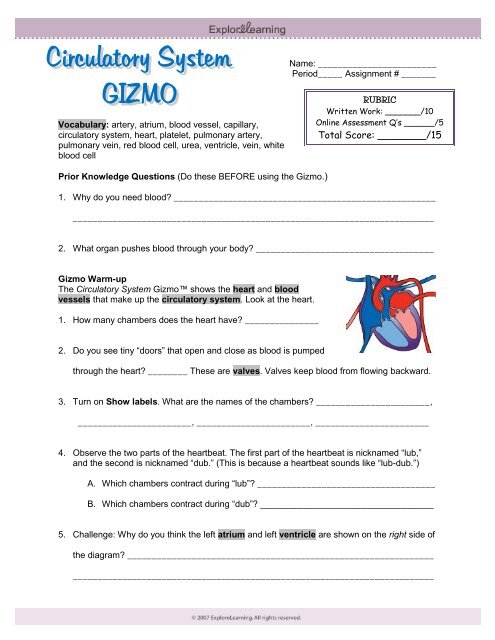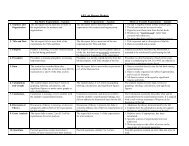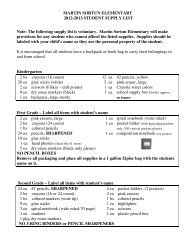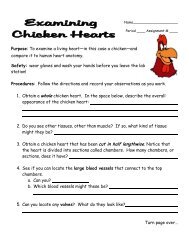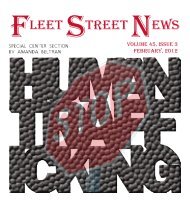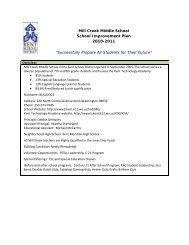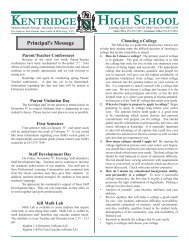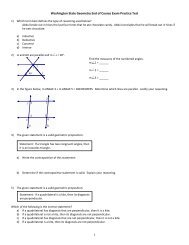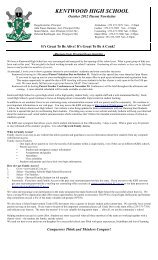Circulatory System Gizmo circulationgizmo.pdf - Kent
Circulatory System Gizmo circulationgizmo.pdf - Kent
Circulatory System Gizmo circulationgizmo.pdf - Kent
You also want an ePaper? Increase the reach of your titles
YUMPU automatically turns print PDFs into web optimized ePapers that Google loves.
Name: ________________________<br />
Period_____ Assignment # _______<br />
Vocabulary: artery, atrium, blood vessel, capillary,<br />
circulatory system, heart, platelet, pulmonary artery,<br />
pulmonary vein, red blood cell, urea, ventricle, vein, white<br />
blood cell<br />
RUBRIC<br />
Written Work: _______/10<br />
Online Assessment Q’s ______/5<br />
Total Score: ________/15<br />
Prior Knowledge Questions (Do these BEFORE using the <strong>Gizmo</strong>.)<br />
1. Why do you need blood? _____________________________________________________<br />
_________________________________________________________________________<br />
2. What organ pushes blood through your body? ____________________________________<br />
<strong>Gizmo</strong> Warm-up<br />
The <strong>Circulatory</strong> <strong>System</strong> <strong>Gizmo</strong> shows the heart and blood<br />
vessels that make up the circulatory system. Look at the heart.<br />
1. How many chambers does the heart have? _______________<br />
2. Do you see tiny “doors” that open and close as blood is pumped<br />
through the heart? ________ These are valves. Valves keep blood from flowing backward.<br />
3. Turn on Show labels. What are the names of the chambers? _______________________,<br />
_______________________, _______________________, _______________________<br />
4. Observe the two parts of the heartbeat. The first part of the heartbeat is nicknamed “lub,”<br />
and the second is nicknamed “dub.” (This is because a heartbeat sounds like “lub-dub.”)<br />
A. Which chambers contract during “lub”? ____________________________________<br />
B. Which chambers contract during “dub”? ___________________________________<br />
5. Challenge: Why do you think the left atrium and left ventricle are shown on the right side of<br />
the diagram? ______________________________________________________________<br />
_________________________________________________________________________
Activity A:<br />
Blood flow<br />
Get the <strong>Gizmo</strong> ready:<br />
Turn off Show labels.<br />
Turn on Show blood flow.<br />
Question: How does blood flow through the heart?<br />
1. Observe: Blood in each chamber of the heart is<br />
represented by little balls. Observe the balls as they<br />
move through the heart and lungs.<br />
2. Label: Turn on Show labels. Label the four chambers<br />
of the heart on the diagram. Then draw arrows to show<br />
the direction that blood flows through the heart.<br />
Starting at the right atrium, in what order does blood<br />
flow through the four chambers?<br />
right atrium, ____________________, ____________________, ____________________<br />
3. Analyze: Observe the path of blood that leaves each ventricle.<br />
A. Where does blood from the right ventricle go? ______________________________<br />
B. Where does blood from the left ventricle go? _______________________________<br />
4. Collect data: Use the syringe to collect a blood sample from the right (blue) side of the<br />
heart. Look at the Data from blood sample on the right side of the <strong>Gizmo</strong>.<br />
A. What is the concentration of oxygen in this sample? ____________________<br />
B. What is the concentration of carbon dioxide in this sample? ____________________<br />
5. Collect data: Collect a sample from the left (red) side of the heart.<br />
A. What is the concentration of oxygen in this sample? ____________________<br />
B. What is the concentration of carbon dioxide in this sample? ____________________<br />
6. Draw conclusions: Between the right ventricle and the left atrium, blood goes through the<br />
lungs. Based on the data you have collected, what happens in the lungs?<br />
_________________________________________________________________________<br />
_________________________________________________________________________
Activity B:<br />
Blood circulation<br />
Get the <strong>Gizmo</strong> ready:<br />
Check that Show labels is on.<br />
Turn on Show blood flow.<br />
Question: How is blood carried to different parts of the body?<br />
1. Observe: Watch the blood after it leaves the left ventricle. What are some places that blood<br />
goes after leaving the heart? __________________________________________________<br />
_________________________________________________________________________<br />
2. Compare: The <strong>Gizmo</strong> shows three types of blood vessels. Arteries carry blood away from<br />
the heart, capillaries carry blood to body cells, and veins carry blood back to the heart.<br />
Locate examples of arteries, veins, and capillaries.<br />
Use the syringe to take blood samples from several different veins and arteries.<br />
A. Which type of blood vessel usually carries oxygen-rich blood? __________________<br />
B. Which type of blood vessel usually carries oxygen-poor blood? _________________<br />
C. In which type of blood vessel is oxygen released into body cells? _______________<br />
3. Challenge: The pulmonary artery carries blood from the right ventricle to the lungs. The<br />
pulmonary vein carries blood from the lungs back to the left atrium. Locate these blood<br />
vessels, and use the syringe to take a blood sample from each.<br />
A. How is the blood in the pulmonary artery different from blood in other arteries?<br />
___________________________________________________________________<br />
B. How is the blood in the pulmonary vein different from blood in other veins?<br />
___________________________________________________________________<br />
4. Extend your thinking: How is the circulatory system similar to a road-and-highway system?<br />
_________________________________________________________________________<br />
_________________________________________________________________________<br />
_________________________________________________________________________<br />
_________________________________________________________________________
Extension:<br />
What’s in your<br />
blood?<br />
Get the <strong>Gizmo</strong> ready:<br />
Take a blood sample from any blood vessel using<br />
the syringe.<br />
Question: What is inside blood?<br />
1. Observe: Look at the Microscopic view of<br />
blood sample. Sketch what you see in the<br />
space at right. (If you like, you could also<br />
click the camera icon to take a <strong>Gizmo</strong><br />
snapshot, and then paste your snapshot into<br />
a blank word-processing document.)<br />
Find and label the following objects in your<br />
sketch:<br />
Red blood cells (small, round cells that carry oxygen)<br />
White blood cells (large, irregular cells that fight disease)<br />
Platelets (tiny fragments that help to stop bleeding when you are cut)<br />
2. Collect data: Blood carries many vital substances. Four of these are listed above the<br />
Microscopic view. Oxygen and sugar are needed by all body cells. Carbon dioxide and<br />
urea are waste products. What are the concentrations of each substance in this sample?<br />
Oxygen: _________ Carbon dioxide: _________ Sugar: _________ Urea: _________<br />
3. Investigate: Take samples of blood from all over the body. Try to determine where sugar<br />
enters the blood, and where it is removed.<br />
A. Where does sugar enter the blood? ______________________________________<br />
B. How can you tell where sugar enters the blood? ____________________________<br />
___________________________________________________________________<br />
C. Where is sugar removed from the blood? __________________________________<br />
D. How can you tell? ____________________________________________________<br />
___________________________________________________________________<br />
4. Investigate: Take blood samples to determine where urea enters the blood and is removed.<br />
A. Where does urea enter the blood? _______________________________________<br />
B. Where is urea removed from the blood? ___________________________________<br />
Don’t forget to do the Assessment Questions below the <strong>Gizmo</strong> when you finish with the above<br />
activities! These are part of your grade!<br />
My Score ______/5


